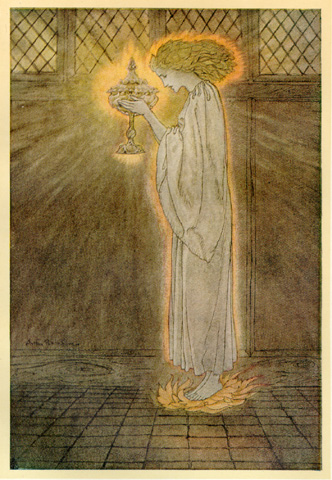 |
| (From QFF) |
The next point which is posed for our consideration is the place of Shekinah in the Sephirotic Tree, and it will be well to state at the inception that the attributions throughout Kabalism seem almost as many as the references, though there is only one which is predominant. She is the Middle Pillar as we have seen the Pillar of Benignity, extending from Kether to Malkuth, and she takes up the Sephiroth to God, or into the place which is no place, beyond the infinite height and depth, the infinite of all directions embraced by the Tree. This is the place of Ain-Soph. The Middle Pillar is described otherwise as the trunk of the Tree, it being understood that the root is in Kether, so far as the genesis and legend of the soul are concerned, but it is in Malkuth in respect of the return journey to God, which is a journey through the Shekinah, or under her glorious leading. Shekinah is, in another form of symbolism, the body of the Tree; and the elect summarised as Israel are the cloud of witnesses forming the branches; but it is said also that she is the crown of the Middle Pillar, the synthesis of all the Sephiroth and of every Sacred Name expressed or implied in the wisdom of the Secret Doctrine. (Arthur Waite)
"The Unity of Thelema and Agape in the number 93 would suggest that, in fact, it is the Number 93 which contains both."
 |
| Fire Walk |
(JC is a Phoenix)
("But Alice doesn't live in the restaurant, she lives in the church nearby the restaurant, in the bell tower with her husband Ray and Facha, the dog.")
 |
| "The milk of the stars from her paps" |
(The Star Child of the Magi)
(Ellie?)
I must append hereto the symbolism of a certain myth which connects with the primeval formulation of the Divine Name and has its origin in the Talmud. As developed in the Zohar, it presents another aspect of that point of Divine Thought about which we heard at the beginning of this chapter. It concerns a mysterious stone called Schethiyd which was originally in the Throne of God that is to say, it was a precious stone or jewel and was cast by Him into the abyss, so to form the basis of the world and give birth thereto. One might say otherwise that it was like a cubical stone or altar, for its extremity was concealed in the depth, while its surface or summit rose above the chaos. It was the central point in the immensity of the world, the corner stone, the tried stone, the sure foundation, but also that stone which the builders rejected. The last allocation, however, passes understanding, as by the hypothesis of the legend it was used in the building from the beginning. Finally but this is not less inscrutable it was that stone which served Jacob as a pillow and thereafter for an altar. It was the good stone, the precious stone and the foundation of Zion. The Tables of the Law were made from it, and it is destined for the salvation of the world. Jacob called it the House of the Elohim, meaning that the Hypostasis to which this name is attributed transfers her residence from the world above to that which is below. It is like the lapis exilis of the German Graal legend, for it appears to be a slight stone; it is supposed to have been carried by Aaron when he entered the Holy Place, and it was held in the hands of David when he desired to contemplate close at hand the glory of his Master. In a sense it fell from heaven, like the stone from the crown of Lucifer, and again it was overturned by the iniquity of man, until Jacob restored it to an upright position. Solomon was also one of those who restored it, and thereon he built the sanctuary. We may not know how to harmonise these references which seem to exhaust all that is said of the stone in the Old Testament, but its connection with other and less fabulous elements belonging to the Zoharic myth of creation resides in the fact that this stone was inscribed with the Divine Name before it was cast into the abyss. . . .
As Elohim she is the Middle Pillar, and all the various aspects of the one thing that is needful from the stand point of the Secret Tradition are collocated, their seeming exclusiveness notwithstanding, to shew that she abides in all, is at once above and below, without even as within. (Waite)
"When used of the true God, 'Elohim' denotes what is called by linguists a plural of majesty, honor, or fullness."
(Who's really in control?)
Lolita: Yes, that's Dick. He doesn't know a thing about you and me ... so please watch what you say. [...]
Humbert: How long have you known him?
Lolita: About a year. I met him in Phoenix. I was working as a waitress.























